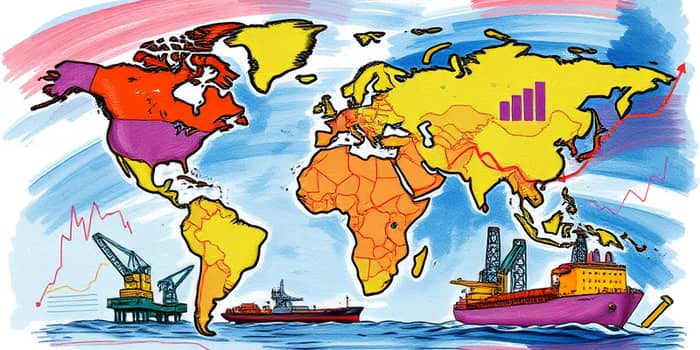
Oil is the lifeblood of modern economies, fueling transportation, power generation, and manufacturing processes that underpin daily life. When oil prices surge or plunge, the impact extends far beyond energy bills, reaching into supply chains, inflation metrics, and national budgets.
Price volatility can influence everything from consumer spending to geopolitical strategy, underscoring the vital link between energy and growth in both developing and advanced nations. Understanding these dynamics is essential for policymakers, investors, and citizens alike.
Every country, regardless of its oil production status, feels the ripple effects of oil price movements. Exporting nations may rejoice in a windfall of revenue, while importers grapple with rising import bills that strain balance of payments and tighten household budgets.
Even minor shifts in the cost of crude can translate into significant changes in inflation and growth forecasts. As central banks monitor commodity indices, a sudden jump in oil costs can trigger interest rate adjustments that affect lending, investment, and consumer confidence worldwide.
The global oil market is shaped by a complex interplay of supply, demand, and policy. Geopolitical tensions, production decisions by OPEC+ members, and the pace of global economic expansion all feed into price formation.
Meanwhile, speculative trading and shifts in inventory levels add layers of uncertainty. Even anticipated moves—such as U.S. policy shifts or a new round of sanctions—can spark large moves as market participants reposition for risk.
Understanding these drivers allows governments and corporations to anticipate challenges and adapt strategies in advance, rather than react when markets have already moved.
Oil-exporting countries often experience immediate fiscal benefits when prices rise sharply. Higher revenues support public spending on infrastructure, education, and social programs, strengthening domestic demand and job creation.
At the same time, dependence on oil income can create distortions. When global benchmarks slide lower, these economies face budget shortfalls, forcing austerity measures that can stifle growth and undermine social stability.
Effective long-term planning for exporters requires building economic resilience through diversification and establishing sovereign wealth funds or stabilization accounts to cushion against inevitable downturns.
Oil-importing nations confront higher costs for transportation, manufacturing, and heating when prices climb. These increases filter through to consumer prices, putting upward pressure on inflation and eroding disposable income.
Central banks often face a dilemma: tighten monetary policy to curb inflation risk slowing growth, while loose policy may fuel overheating and further price pressures. Careful calibration is required to maintain stability.
However, lower oil prices can provide a window of opportunity for fiscal stimulus, enabling governments to invest in social welfare or infrastructure without exacerbating deficits.
Beyond price levels, volatility itself creates uncertainty for investors, businesses, and governments. Sudden swings make budgeting and forecasting challenging, leading some firms to delay expansion or hiring decisions.
High volatility undermines long-term corporate investment decisions, as companies struggle to forecast costs and demand. Consumers, too, may pull back on discretionary spending when energy markets are unpredictable.
The oil crises of the 1970s, the 2008 price spike, the 2014–2016 collapse, and the 2020 pandemic-driven plunge each offer unique insights. In every case, the shock reverberated through stock markets, trade balances, and policy debates.
Lessons learned from past crises emphasize the need for robust contingency planning and resilience measures in both public and private sectors. Countries that diversified early weathered downturns more effectively.
To soften the impact of volatile oil markets, policymakers and corporations can adopt a suite of proactive measures. These range from strategic reserves to long-term supply contracts and investment in alternative energy.
By combining fiscal prudence with market flexibility, stakeholders can manage risk while pursuing growth opportunities. Collaboration across borders and industries further enhances resilience.
Embracing these actions helps economies maintain momentum through price swings and positions them to seize emerging opportunities in a transitioning energy landscape.
As non-OPEC production expands and the energy transition accelerates, the outlook for oil prices remains uncertain. New technologies, environmental policies, and shifting demand patterns will all play roles.
Investors and governments must track evolving trends—from electric vehicle adoption to carbon pricing—to align strategies with long-term shifts. Those who adapt proactively can gain a competitive edge, even in a volatile environment.
The influence of oil prices on global economies underscores the interconnected nature of energy, finance, and geopolitics. While high prices can drive growth in some regions, they can simultaneously strain others.
By acknowledging both the power and pitfalls of oil markets and embracing holistic, forward-looking policies, nations and businesses can navigate uncertainty and build sustainable prosperity for the decades ahead.
References













